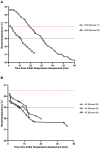Athlete Medical Services at the Marathon and Race Walking Events During Tokyo 2020 Olympics
- PMID: 35529419
- PMCID: PMC9072790
- DOI: 10.3389/fspor.2022.872475
Athlete Medical Services at the Marathon and Race Walking Events During Tokyo 2020 Olympics
Abstract
Epidemiological data from race walk and marathon events suggest that a high incidence rate of exertional heat illness is associated with high ambient temperature and relative humidity. The 2020 Summer Olympics in Tokyo was no exception, which led the organizing committee to relocate the race walk and marathon competitions to Sapporo, which was predicted to experience much milder heat. Nonetheless, during the Games, Sapporo recorded the highest daytime ambient temperature in the past 97 years, with consecutive days over 30°C from July 22nd to August 7th, 2021. Five events (men's and women's 20 km race walk, men's 50 km race walk, women's and men's marathon) were held in Sapporo from August 5th to August 8th, 2021. The percentage of athletes who did not finish (DNF) in each event was 8.8% in men's 20 km race walk, 20.3% in men's 50 km race walk, 8.6% in women's 20 km race walk, 17.1% in women's marathon and 28.3% in men's marathon. A total of fifty athletes were transferred to the athlete medical station: 28 athletes completed the race (i.e., collapsed after finish line), while 24 were DNF athletes transported from the course. Forty-eight (96%) of athletes who were admitted to the athlete medical station exhibited signs and symptoms of exertional heat illness. Two athletes diagnosed with exertional heat stroke and three athletes diagnosed with severe heat exhaustion (rectal body temperature >39.5°C with or without central nervous system disturbance) were cooled using whole-body cold water immersion at the heat deck located within the athlete medical station. All athletes who were cooled successfully recovered without any complications. These athletes required an average of 14 ± 9.4 min (range, 6-30 min) to cool their rectal temperature below 39°C. These results show the importance for event organizers to prepare strategies to keep athletes cool, such as an ample amount of ice and water to supply whole-body cold water immersion.
Keywords: Olympic Games; exertional heat illness; marathon; race medicine; race walk.
Copyright © 2022 Sugawara, Manabe, Yamasawa and Hosokawa.
Conflict of interest statement
The authors declare that the research was conducted in the absence of any commercial or financial relationships that could be construed as a potential conflict of interest.
Figures



Similar articles
-
Incidence and factor analysis for the heat-related illness on the Tokyo 2020 Olympic and Paralympic Games.BMJ Open Sport Exerc Med. 2023 Apr 7;9(2):e001467. doi: 10.1136/bmjsem-2022-001467. eCollection 2023. BMJ Open Sport Exerc Med. 2023. PMID: 37051574 Free PMC article.
-
Competing in Hot Conditions at the Tokyo Olympic Games: Preparation Strategies Used by Australian Race Walkers.Front Physiol. 2022 Mar 23;13:836858. doi: 10.3389/fphys.2022.836858. eCollection 2022. Front Physiol. 2022. PMID: 35399272 Free PMC article.
-
New sports, COVID-19 and the heat: sports injuries and illnesses in the Tokyo 2020 Summer Olympics.Br J Sports Med. 2022 Dec 13:bjsports-2022-106155. doi: 10.1136/bjsports-2022-106155. Online ahead of print. Br J Sports Med. 2022. PMID: 36588430
-
Recognition and treatment of exertional heat illness at a marathon race.Prehosp Emerg Care. 2014 Jul-Sep;18(3):456-9. doi: 10.3109/10903127.2013.864357. Epub 2014 Jan 24. Prehosp Emerg Care. 2014. PMID: 24460521 Review.
-
Looking ahead of 2021 Tokyo Summer Olympic Games: How Does Humid Heat Affect Endurance Performance? Insight into physiological mechanism and heat-related illness prevention strategies.J Therm Biol. 2021 Jul;99:102975. doi: 10.1016/j.jtherbio.2021.102975. Epub 2021 Apr 22. J Therm Biol. 2021. PMID: 34420619 Review.
Cited by
-
Physical and Physiological Demands of Official Beach Soccer Match-Play in Relation to Environmental Temperature.Sports (Basel). 2025 Apr 14;13(4):118. doi: 10.3390/sports13040118. Sports (Basel). 2025. PMID: 40278744 Free PMC article.
-
Incidence and factor analysis for the heat-related illness on the Tokyo 2020 Olympic and Paralympic Games.BMJ Open Sport Exerc Med. 2023 Apr 7;9(2):e001467. doi: 10.1136/bmjsem-2022-001467. eCollection 2023. BMJ Open Sport Exerc Med. 2023. PMID: 37051574 Free PMC article.
-
Exertional Heat Stroke and Rhabdomyolysis: A Medical Record Review and Patient Perspective on Management and Long-Term Symptoms.Sports Med Open. 2023 May 19;9(1):33. doi: 10.1186/s40798-023-00570-y. Sports Med Open. 2023. PMID: 37204519 Free PMC article.
-
Validation of upper thermal thresholds for outdoor sports using thermal physiology modelling.Temperature (Austin). 2023 May 14;11(1):92-106. doi: 10.1080/23328940.2023.2210477. eCollection 2024. Temperature (Austin). 2023. PMID: 38577294 Free PMC article.
-
Injuries and illness of athletes at the Tokyo 2020 Olympic and Paralympic summer games visiting outside facilities.Sports Med Health Sci. 2024 Jan 17;6(1):48-53. doi: 10.1016/j.smhs.2024.01.003. eCollection 2024 Mar. Sports Med Health Sci. 2024. PMID: 38463667 Free PMC article.
References
-
- Athlete365 Beat the heat at Tokyo 2020. Available online at: https://olympics.com/athlete365/games-time/beat-the-heat/ (accessed January 26 2022).
-
- Japan Meteorological Agency Past Weather Database. Available online at: https://www.data.jma.go.jp/obd/stats/etrn/index.php?prec_no=andblock_no=... (accessed February 21, 2022)..
-
- Adami P. E., Bermon S., Garrandes F., Guadagnini G. (2020). Competition Medical Guidelines for World Athletics Series Events A Practical Guide October 2020-Second Edition.
LinkOut - more resources
Full Text Sources
Miscellaneous

